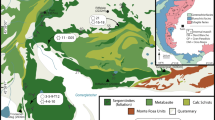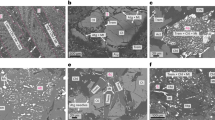Abstract
The MgO content of komatiite lavas is an important measure of their formation temperature deep in the Archaean mantle, and forms the basis for models of the early Earth's thermal and chemical evolution1,2,3,4,5. Estimates of the primary MgO content of komatiites are sensitive to the oxidation state—characterized by the oxygen fugacity ()—assumed for the magmas during their crystallization. Despite two decades of study, however, is still poorly constrained for these lavas. Here I present an estimate of the for komatiite flows, based on the systematics of vanadium partitioning between komatiitic liquid and olivine in six well-characterized komatiite flows of varying ages. This approach shows that the oxidation state of several of these Archaean lava flows was the same as, or possibly more oxidizing than, that of present-day oceanic basalts. These results may require a downward revision of the mantle melting temperature estimated for many komatiites by about 50 °C, and suggest that the mantle was unlikely to be much less oxidized during the Archaean era than at present.
This is a preview of subscription content, access via your institution
Access options
Subscribe to this journal
Receive 51 print issues and online access
$199.00 per year
only $3.90 per issue
Buy this article
- Purchase on Springer Link
- Instant access to full article PDF
Prices may be subject to local taxes which are calculated during checkout


Similar content being viewed by others
References
Viljoen, M. J. & Viljoen, R. P. Evidence for the existence of a mobile extrusive peridotitic magma from the Komati Formation of the Onverwacht Group. Geol. Soc. S. Afr. Spec. Publ. 3, 87–112 (1969).
Arndt, N. T. & Nisbet, E. G. (eds) Komatiites(Allen and Unwin, London, (1982)).
Green, D. H., Nicholls, R. A., Viljoen, M. J. & Viljoen, R. P. Experimental determination of the existence of peridotic liquids in earliest Archean magmatism. Geology 3, 15–18 (1975).
Nisbet, E. G., Cheadle, M. J., Arndt, N. T. & Bickle, M. J. Constraining the potential temperature of the Archean mantle: a review of the evidence from komatiites. Lithos 30, 291–307 (1993).
Herzberg, C. Depth and degree of melting of komatiites. J. Geophys. Res. 97, 4521–4540 (1992).
Carmichael, I. S. E. The redox states of basic and silicic magmas: a reflection of their source regions? Contrib. Mineral. Petrol 106, 129–141 (1991).
Kilinc, A., Carmichael, I. S. E., Rivers, M. L. & Sack, R. O. Ferric–ferrous ratio of natural silicate liquids equilibrated in air. Contrib. Mineral. Petrol. 83, 136–140 (1983).
Beswick, A. E. in Komatiites 283–308 (Allen and Unwin, London, (1982)).
Smith, H. S. & Erlank, A. in Komatiites 347–397 (Allen and Unwin, London, (1982)).
Carmichael, I. S. E. & Ghiorso, M. S. Controls on oxidation–reduction relations in magmas. Rev. Mineral., Miner. Soc. Am. 24, 191–212 (1990).
Hanson, B. Z., Jones, J. H. & Gaetani, G. A. Partition coefficients for Cr2+ and Cr3+ between olivine and liquid are virtually identical: Cr and V partitioning among olivine, spinel and silicate liquid over a wide range of fO2's. EOS Trans. Am. Geophys. Un. 77, 846 (1996).
Rammensee, W., Palme, H. & Wänke, H. Experimental investigation of metal-silicate partioning of some lithophile elements (Ta, Mn, V, Cr). Lunar. Planet. Sci. XIV, 628–629 (1983).
Arndt, N. T. Differentiation of komatiite flows. J. Petrol 27, 279–302 (1986).
Thy, P. Low pressure experimental constraints on the evolution of komatiites. J. Petrol 36, 1529–1548 (1995).
Cattell, A. & Arndt, N. Low- and high-alumina komatiites from a late Archaean sequence, Newton Township, Ontario. Contrib. Mineral. Petrol. 97, 218–227 (1987).
Green, T. H. Experimental studies of trace-element partitioning applicable to igneous petrogenesis—Sedona 16 years later. Chem. Geol. 117, 1–36 (1994).
Lahaye, Y. et al. The influence of alteration on the trace element and Nd isotopic compositions of komatiites. Chem. Geol. 126, 43–64 (1995).
Horn, I., Foley, S. F., Jackson, S. E. & Jenner, G. A. Experimentally determined partitioning of high field strength- and selected transition elements between spinel and basaltic melts. Chem. Geol. 117, 194–218 (1994).
McDonough, W. F. & Ireland, T. R. Intraplate origin of komatiites inferred from trace elements in glass inclusions. Nature 365, 432–434 (1993).
Christie, D. M., Carmichael, I. S. E. & Langmuir, C. H. Oxidation states of mid-ocean ridge basalt glasses. Earth Planet. Sci. Lett. 79, 397–411 (1986).
Kress, V. C. & Carmichael, I. S. E. The compressibility of silicate liquids containing Fe2 O 3 and the effect of composition, temperature, oxygen fugacity and pressure on their redox states. Contrib. Mineral. Petrol. 108, 82–92 (1991).
Eggler, D. H. & Lorand, J. P. Sulfides, diamonds and mantle fO2. Proc. 5th Int. Kimb. Conf. 160–169 (CPRM Brasilia, Brasilia, (1994).
Takahashi, E. Speculations on the Archean mantle: missing link between komatiite and depleted garnet peridotite. J. Geophys. Res. 95, 15941–15954 (1990).
Nisbet, E. G. et al. Unique fresh 2.7 Ga komatiites from the Belingwe greenstone belt, Zimbabwe. Geology 15, 1147–1150 (1987).
Viljoen, M. J., Viljoen, R. P., Smith, H. S. & Erlank, A. J. Geological, textural and geochemical features of komatiitic flows from the Komati Formation. Spec. Publ. Geol. Soc. S. Afr. 9, 1–20 (1983).
Smith, H. S., Erlank, A. J. & Duncan, A. R. Geochemistry of some ultramafic komatiite flows from the Barberton Mountain Land, South Africa. Precamb. Res. 11, 399–415 (1980).
Arndt, N. T. & Lesher, C. M. Fractionation of REEs by olivine and the origin of Kambalda komatiites, Western Australia. Geochim. Cosmochim. Acta 56, 419–4204 (1992).
Acknowledgements
This research was supported by research and equipment grants from NSERC of Canada. This paper benefited from reviews by H. Palme and N. Arndt, and from the encouragement of C.Fischer.
Author information
Authors and Affiliations
Corresponding author
Rights and permissions
About this article
Cite this article
Canil, D. Vanadium partitioning and the oxidation state of Archaean komatiite magmas. Nature 389, 842–845 (1997). https://doi.org/10.1038/39860
Received:
Accepted:
Issue Date:
DOI: https://doi.org/10.1038/39860
This article is cited by
-
Mineral-melt vanadium oxybarometry for primitive arc magmas: effect of hydrous melt composition on fO2 estimates
Contributions to Mineralogy and Petrology (2024)
-
Petrogenesis, oxidation state and volatile content of Dongga tonalite in the Gangdese belt, Xizang: Implication for porphyry Cu mineralization
Acta Geochimica (2024)
-
Copper behavior in arc-back-arc systems: Insights into the porphyry Cu metallogeny of the Gangdese belt, southern Tibet
Mineralium Deposita (2024)
-
Sub-arc mantle fugacity shifted by sediment recycling across the Great Oxidation Event
Nature Geoscience (2023)
-
Trace element partitioning in basaltic systems as a function of oxygen fugacity
Contributions to Mineralogy and Petrology (2023)
Comments
By submitting a comment you agree to abide by our Terms and Community Guidelines. If you find something abusive or that does not comply with our terms or guidelines please flag it as inappropriate.



